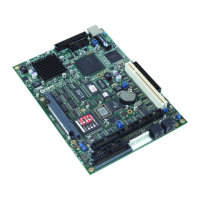SBC-GX1 Technical Manual Detailed hardware description
Real time clock
The Real time clock is fully compatible with the PC/AT standard clock device. The date
and time functions are stored in the real time clock when the main power is removed as
long as the battery backup supply is enabled (see
LK3 description). As well as providing
time and date information, the real time clock stores the BIOS settings. The real time
clock is decoded in I/O address space at 70-71H and is connected to IRQ8. The real
time clock registers are accessed via an indexed addressing mechanism. I/O location
70H is used to select the appropriate register and 71H is used to access the data.
The maximum rated current for the real time clock is 2uA and the battery backup supply
is provided by a Lithium coin cell with a capacity of 180mA. This battery provides
sufficient support for at least 10 years. The battery is disabled during shipment to
prolong the useful life. If the board is going to be placed out of service for long periods
of time then the battery should also be disabled. If the main supply is present on the
board the battery automatically gets disconnected from the real time clock circuitry.
The accuracy of the real time clock is based on the operation of the 32.768KHz watch
crystal. This provides an accuracy of +/-1 minute per month if the board is in an ambient
environment of +25
o
C (77
o
F). When the board operates beyond this temperature, then
the accuracy may be degraded.
Keyboard/mouse controller
An 8042 compatible keyboard controller provides support for a standard PC/AT
keyboard and mouse. Both interfaces use a 6-pin mini-Din style connector. The
keyboard is connected via PL7 and mouse via PL9. The keyboard controller is decoded
at I/O address location 60-64H and uses IRQ1 for keyboard and IRQ12 for mouse
support. Power for the keyboard and mouse is sourced from the +5V supply and a
resettable fuse protects the board if either interface is short circuited.
The development kit is supplied with a PS/2 to AT adapter cable that can be used to
convert between the mini-DIN connector and the standard AT style connector. The
development kit also contains a PS/2 mouse that plugs directly into PL9.
The Award BIOS automatically detects the presence of the keyboard and mouse, and
provides support for these. If these devices are not plugged in, the BIOS continues to
operate correctly.
Ethernet controller
A National Semiconductor DP83815 Ethernet controller provides a 10/100-BaseTX
interface. This is a 32-bit PCI device that is configured by the Plug and Play BIOS
during power ON. The device provides compliance with IEEE802.3u 100BASE-T
specification and IEEE 802.3x Full Duplex Flow Control. A 93C46 EEPROM is used to
store configuration data and ID information.
An 8-way RJ45 connector is used to provide signals. (See
Appendix B – Connector
details
for pin assignment details.)
A second connector PL3 also provides users with status signals that are designed to
drive LED’s. The status lines provide 10M, 100M and LINK status. The output lines sink
© 2004 Arcom Issue D 73

